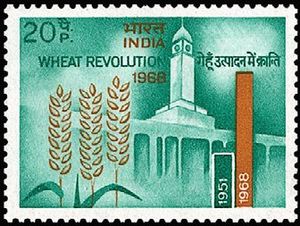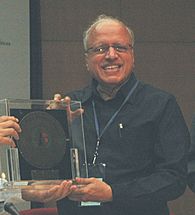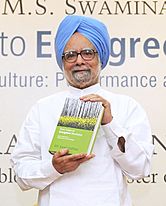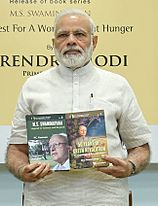M. S. Swaminathan facts for kids
Quick facts for kids
M. S. Swaminathan
|
|
|---|---|

Swaminathan in 2013
|
|
| Member of Parliament, Rajya Sabha | |
| In office 2007–2013 |
|
| Constituency | Nominated |
| Born | 7 August 1925 Kumbakonam, Tanjore District, Madras Presidency, British India
(present-day Thanjavur, Tamil Nadu, India) |
| Died | 28 September 2023 (aged 98) Chennai, Tamil Nadu, India
|
| Nationality | Indian |
| Alma mater |
|
| Spouse(s) |
Mina Swaminathan
(m. 1955; died 2022) |
| Children | 3; including Soumya |
| Awards | • Padma Shri (1967) • Ramon Magsaysay Award (1971) • Padma Bhushan (1972) • World Food Prize (1987) • Padma Vibhushan (1989) |
| Scientific career | |
| Fields | Botany, Plant genetics, Genetics, Cytogenetics, Ecological economics, Plant breeding, Ecotechnology |
| Institutions |
|
| Thesis | Species Differentiation, and the Nature of Polyploidy in certain species of the genus Solanum–section Tuberarium (1952) |
| Doctoral advisor | H. W. Howard |
Mankombu Sambasivan Swaminathan (born August 7, 1925 – died September 28, 2023) was an important Indian scientist. He was an expert in agriculture and plant genetics. Swaminathan is famous for leading the Green Revolution in India. This was a huge effort to grow more food and prevent famine in the 1960s.
He worked with another scientist, Norman Borlaug, to bring new, high-yielding types of wheat and rice to India. Their work, along with help from farmers and government policies, saved many people from hunger. The United Nations Environment Programme even called him the "Father of Economic Ecology." This means he found ways to help the economy while also protecting nature.
Swaminathan also did important research on potatoes, wheat, and rice. He won many awards, including the first World Food Prize in 1987. This is one of the highest honors in agriculture. In 1999, Time magazine named him one of the 20 most important Asian people of the 20th century. He was nominated to the Parliament of India (the country's law-making body) from 2007 to 2013. During this time, he worked to get women farmers officially recognized.
Life Story
Early Years and School
Swaminathan was born in Kumbakonam, India, on August 7, 1925. He was the second son in his family. When he was 11, his father passed away, and his uncle helped raise him.
He went to school in Kumbakonam. From a young age, he saw how farming worked. His family grew rice, mangoes, and coconuts. He understood how weather and pests could ruin crops and how prices affected farmers.
His parents wanted him to become a doctor. He started studying zoology (the study of animals). But during World War II, he saw the terrible Bengal famine of 1943. This made him decide to help India grow enough food for everyone. Even though medicine was seen as a more important job, he chose agriculture.
He earned a science degree in agriculture from the University of Madras. In 1947, he moved to the Indian Agricultural Research Institute (IARI) in New Delhi. There, he studied genetics (how traits are passed down) and plant breeding (creating new plant types). He focused on potatoes for his research. He even passed exams to join the police force, but he chose to study genetics instead.
Studying Abroad
Swaminathan received a special scholarship to study genetics in the Netherlands. He worked on making potatoes stronger against pests and cold weather. This experience helped him think about how to grow more food in India.
In 1950, he went to the University of Cambridge in the United Kingdom. He earned his PhD in 1952, studying how different types of potatoes developed. After that, he spent 15 months at the University of Wisconsin in the United States. He helped set up a potato research station there. He was offered a job in the U.S., but he decided to return to India to help his home country.
Making a Difference in India
Swaminathan came back to India in 1954. There weren't many jobs in his field at first. He soon got a temporary job at the Central Rice Research Institute. Later, he joined the Indian Agricultural Research Institute (IARI) in New Delhi. He was worried because India was importing a lot of food, even though most of its people were farmers. Droughts were also causing food shortages.
Swaminathan worked with Norman Borlaug, an American scientist. Borlaug sent special dwarf wheat seeds from Mexico to India. These seeds could produce much more grain. Swaminathan tested them, and they grew very well. Farmers were unsure at first because the yields were so high.
In 1964, Swaminathan got money to show farmers how well the new wheat grew. They planted 150 small test plots. The results were amazing, and farmers became less worried. Scientists made more changes to the wheat to make it perfect for India. By 1968, wheat production jumped to 17 million tons. This was 5 million tons more than before!
Norman Borlaug, who later won the Nobel Prize, wrote to Swaminathan. He said that Swaminathan deserved a lot of credit for seeing the potential of the Mexican wheat. He believed that without Swaminathan, there might not have been a Green Revolution in Asia. By 1971, India was producing enough food for itself. Swaminathan then focused on making sure everyone had access to food and good nutrition.
Leading Agricultural Organizations
In 1972, Swaminathan became the head of the Indian Council of Agricultural Research (ICAR). He also became a high-ranking government official. He worked to spread agricultural knowledge across India by setting up new centers. During droughts, he created groups to track weather and crops. This helped protect poor people from hunger.
From 1982 to 1988, he was the first Asian director-general of the International Rice Research Institute (IRRI) in the Philippines. He organized a big meeting called "Women in Rice Farming Systems." Because of this, he received an award for helping women in development. He also taught rice-growing families how to use every part of the rice plant. His leadership at IRRI helped him win the first World Food Prize.
In 1987, he used his World Food Prize money to start the MS Swaminathan Research Foundation. When he accepted the award, he talked about how hunger still existed even with more food. He said that the goal of a world without hunger was not yet finished.
Building Research Centers
Swaminathan helped create many important research centers. He set up the Nuclear Research Laboratory at the IARI. He also helped start the International Crops Research Institute for the Semi-Arid Tropics in India. He supported research in many other countries like China, Vietnam, and Pakistan.
Later Years and Legacy
From 2002 to 2005, Swaminathan helped lead the United Nations Millennium Project on hunger. He also chaired the Pugwash Conferences on Science and World Affairs, which focuses on peace and science.
In 2004, he led the National Commission on Farmers. This group suggested ways to make farming better in India. In 2007, he was nominated to the Rajya Sabha, which is a part of India's Parliament. He introduced a bill to recognize women farmers, but it did not become law.
Swaminathan created the term 'Evergreen Revolution'. This idea means increasing food production forever without harming the environment. He also worked on bridging the digital divide (the gap between those with and without access to technology). He wanted to bring research findings to people who make decisions about hunger and nutrition.
Family and Passing
M. S. Swaminathan was married to Mina Swaminathan. They had three daughters: Soumya, Madhura, and Nitya. He passed away at his home in Chennai on September 28, 2023, at the age of 98.
Scientific Work
Potato Research
In the 1950s, Swaminathan made a big contribution by explaining how potatoes developed. His research helped scientists transfer useful genes from wild potato plants to the potatoes we eat. This made it easier to create new, better potato types. While studying in the U.S., he even helped develop a potato that could resist frost.
Wheat Research
In the 1950s and 1960s, Swaminathan did important research on wheat. The types of wheat and rice he developed with Norman Borlaug were key to the Green Revolution.
Rice Research
At IRRI, Swaminathan started efforts to grow rice that could use sunlight and water more efficiently. He also played a part in creating the world's first high-yielding basmati rice.
Radiation Botany
Swaminathan's team at IARI was known for its research on how radiation affects plants. He set up a 'Cobalt-60 Gamma Garden' to study how radiation could cause changes (mutations) in plants. This research aimed to make plants respond better to fertilizers and show how plant mutations could be used in real life.
Awards and Recognition
Swaminathan received many awards from around the world. In 1965, he got the Mendel Memorial Medal. Later, he received the Ramon Magsaysay Award (1971), the Albert Einstein World Award of Science (1986), and the first World Food Prize (1987). When he accepted the Ramon Magsaysay Award, he quoted Seneca, saying, "A hungry person listens neither to reason, nor to religion, nor is bent by any prayer."
He was also honored by the Philippines, France, the Netherlands, and Cambodia. China gave him an award for international cooperation on environment and development. In the 'Dr Norman E. Borlaug Hall of Laureates' in the U.S., there is a special artwork of Swaminathan made from 250,000 pieces of glass. The IRRI named a building and a scholarship fund after him.
In India, he received the Shanti Swarup Bhatnagar Award in 1961. He also got the Padma Shri, Padma Bhushan, and Padma Vibhushan awards, which are high honors from the Indian government. By 2016, he had received 33 national and 32 international awards. An annual award for leadership in agriculture is now named after him.
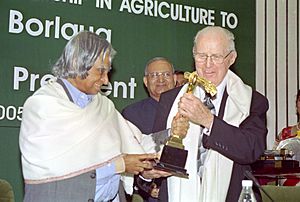
Honorary Degrees and Fellowships
Swaminathan received 84 honorary doctorates (special degrees given to honor someone's achievements). Many universities in India and around the world honored him. When the University of Massachusetts, Boston gave him a science doctorate, they praised his wide-ranging concerns. They noted how he cared about different nations, social groups, genders, and both people and nature.
He was also chosen as a fellow (a special member) of many science academies in India and 30 academies worldwide.
Publications
Swaminathan wrote many scientific papers, with 254 in total. He was the main author or first author on 155 of them. His papers covered topics like improving crops, genetics, and how different plant types are related. He also wrote several books about his life's work, protecting nature, and growing food in a way that helps stop hunger.
Images for kids


